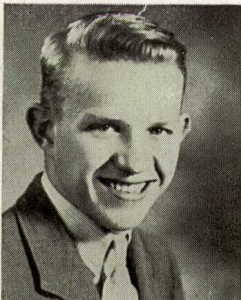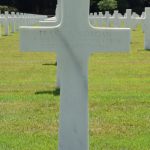1st Lt. Frank B. Morgan (January 28, 1920 – December 20, 1944)
555th Bomber Squadron, 386th Bomber Group, Medium
by Devin Calligy and Elizabeth Klements
Early Life
Frank Black Morgan was born in Greensburg, PA, on January 28, 1920, to Samuel and Edna Grace Morgan.1 Samuel was a first-generation American of Northern Irish descent, while Edna Grace (née Black) was a native of Pennsylvania. The couple lived in Greensburg where they had three sons: Samuel Cree (1909), James Alexander (1912), and Frank Black. Samuel Sr. worked in the publishing industry as an editor and linotype operator, which allowed him to support his family without the assistance of his wife and children. While it was common at the time for sons to leave school early to help the family, all three Morgan boys were able to finish high school and enter college.2 Frank graduated from Greensburg High School in 1937 at the age of seventeen. There, he was part of the Dramatic Club, Tennis Club, Golf Club, Rifle Club, and Football Team. According to the yearbook, he also enjoyed reading and dancing, and planned to go to college to become a business executive. He seems to have been an intelligent, athletic, and ambitious young man.3
On December 6, 1939, Samuel Sr. passed away, at the age of 71.4 After this point, members of the family began to move to Florida. Sometime between 1940 and 1942, Samuel Jr. and James Alexander moved to Fort Pierce, FL, where they worked at Hobby Sales & Service and McCrory Stores, Inc., respectively.5 During this period, Edna remained in Greensburg with Frank, who enrolled as a pre-law student at the Saint Vincent College near Pittsburgh and worked for the Pennsylvania Rubber Company.6 When the war began, Frank registered for the draft, then, in early 1942, he applied to enter Aviation Cadet training. The US Air Corp’s training program was highly selective: applicants had to pass a series of educational, physical, and psychological tests to be accepted. It is likely that Frank’s high-school athletics and college-level education made him an ideal candidate, because the program accepted him in February 1942, at which point he left Pennsylvania for Orlando, FL.7
Military Service
According to official records, Frank entered active service on April 27, 1942, which was likely when his aviation training officially began.8 In the Aviation Cadet program, the participants trained for about seven to eight months as pilots or other aircraft-support roles. After training, they entered the Air Force as Second Lieutenants for the average enlistment period, which was “the duration of the war, plus six months.”9 When his training ended, Frank became 2nd Lt. Morgan, and entered the 555th Bomber Squadron, a unit in the 386th Bomber Group.10
The Air Force activated the 555th Bomber Squadron on December 1, 1942, and based it at MacDill Field, Tampa, FL. In June 1943, they sent it overseas to participate in the combat at the European Theater. Frank’s squadron attacked targets of strategic interest, such as bridges, airfields, marshalling yards, flying bomb sites, communications centers, village and troop defense, coastal guns and shore defenses, and supply depots and dumps. It first went to England, where, between June 1943 and June 1944, it participated in the Air Offensive against Europe, intercepting Luftwaffe planes and bombing Allied targets in Europe. From June to October 1944, it participated in the D-Day operations at Normandy, and the campaign to retake Northern France.11
Once the Allied forces liberated nearly all of France, the squadron transferred to a new base at there at Beaumont-sur-Oise. There, throughout the winter of 1944, it helped Allied forces at two fronts: the Ardennes Forest at the Franco-Belgian border, where German troops tried to break through Allied lines in the Battle of the Bulge, and the Rhineland region on the Franco-German border, where the Germans launched a final offensive called “Operation Nordwind.”12 During this period, Frank died from “non-battle” causes.13 It is possible that his plane may have crashed in take-off or landing.
Legacy
Frank B. Morgan died on December 20, 1944, at the age of twenty-four. In his two years of service, he had risen to the rank of First Lieutenant and earned an Air Medal with eight Oak Leaf Clusters.14 The Air Force awards the Air Medal for acts of heroism or meritorious achievement while in flight, and each Oak Leaf Cluster represents a subsequent Air Medal award, meaning that the Air Force awarded Morgan for heroism nine times. Throughout the course of the war, Frank’s bomber group took part in 409 missions, 12,496 sorties, attacked 433 targets and dropped 18,287 tons of bombs. Of the 409 missions flown by the 386th, enemy fire shot down 49 aircraft and 175 of its members died or went missing in action.15 The details of Frank’s awards are unknown, but in such conditions, he would have had many opportunities to act in a heroic or meritorious fashion.
The US Army buried Frank at Plot B, Row 39, Grave 46, at the Epinal American Cemetery in France.16 Back home in Pennsylvania, his family organized a memorial stone for him at Parker Presbyterian Cemetery, next to his father’s headstone.17 Frank left behind his mother and two brothers, both of whom also served in the US Armed Forces during the war but made it home safely.18 By 1950, Edna Morgan moved down to St. Petersburg, FL, to be with her two remaining sons. There, she applied to the Pennsylvania Veterans Bureau for compensation for Frank’s death, as he had been living with her and likely helped support her before he enlisted. The state of Pennsylvania granted her the full compensation of $500.19 Edna passed away in 1966 and was buried near her husband and son in the Parker Presbyterian Cemetery.20
1 “U.S., World War II Draft Cards Young Men, 1940-1947,” database, Ancestry (https://www.ancestry.com/imageviewer/collections/2238/images/44033_11_00208-00683?usePUB=true&_phsrc=Uqp3112&_phstart=successSource&usePUBJs=true&pId=8446296: accessed June 9, 2021), entry for Frank Black Morgan; “1930 U.S. Census,” database, Ancestry (https://www.ancestry.com/imageviewer/collections/6224/images/4639493_00023?treeid=&personid=&rc=&usePUB=true&_phsrc=Uqp3117&_phstart=successSource&pId=56801276 : accessed June 9, 2021), entry for Frank Morgan.
2 “1930 U.S. Census;” “1940 U.S. Census,” database, Ancestry (https://www.ancestry.com/imageviewer/collections/2442/images/M-T0627-03630-00188?treeid=&personid=&rc=&usePUB=true&_phsrc=Uqp3118&_phstart=successSource&pId=18723898: accessed June 9, 2021), entry for Frank B. Morgan.
3 “U.S., School Yearbooks, 1880-2012,” database, Ancestry (https://www.ancestry.com/discoveryui-content/view/312697835:1265: accessed June 9, 2021), entry for Frank Morgan, Greensburg High School, 1937.
4 “U.S., Pennsylvania, Death Certificates,” database, Ancestry (www.ancestry.com: accessed June 9, 2021), entry for Samuel Morgan.
5 “U.S., World War II Draft Cards Young Men, 1940-1947,” database, Ancestry (www.ancestry.com: accessed June 9, 2021), entry for James Alexander Morgan, and entry for Samuel Cree Morgan.
6 “U.S., World War II Draft Cards Young Men, 1940-1947,” entry for Frank Black Morgan; “Joins Cadets,” Latrobe Bulletin (Latrobe, Pennsylvania), February 19, 1942, https://www.newspapers.com/clip/79128947/frank-morgan-joins-cadets/.
7 “Joins Cadets;” Bruce Ashcroft, We Wanted Wings: A History of the Aviation Cadet Program (HQ AETC Office of History and Research, 2005), 33 – 34.
8 “Pennsylvania, Veteran Compensation Application Files, WWII,” database, Ancestry (https://search.ancestry.com/cgi-bin/sse.dll?indiv=1&dbid=3147&h=1434764&ssrc=pt&tid=76592314&pid=140118451671&usePUB=true: accessed June 10, 2021), entry for Frank B. Morgan.
9 Ashcroft, We Wanted Wings, 31.
10 “U.S., Headstone and Internment Records,” database, Ancestry (https://www.ancestry.com/imageviewer/collections/9170/images/42861_1521003238_0917-00001?treeid=&personid=&rc=&usePUB=true&_phsrc=Uqp3130&_phstart=successSource&pId=24592: accessed June 10, 2021), entry for Frank B. Morgan. See image at the RICHES Epinal American Cemetery Collection here.
11 Maurer, The Combat Squadrons of the Air Force, World War II (USAF Headquarters: Office of Air Force History, 1982), 657, accessed via Fold3, https://www.fold3.com/image/676407766; U.S. Air Force, The History of a Bombing Outfit: the 386th Bomb Group (USAF Headquarters, 1945), 3 – 15.
12 Maurer, The Combat Squadrons, 657; Air Force, The History of a Bombing Outfit, 15 – 21.
13 “WWII Army and Air Force Casualty List,” database, Fold3 (https://www.fold3.com/image/310763078: accessed June 10, 2021), entry for Frank B. Morgan, O-750431, St. Lucie County, Florida.
14 “U.S., Headstone and Internment Records.”
15 Air Force, The History of a Bombing Outfit, 2 – 3.
16 “U.S. Headstone and Internment Records.”
17 “Lieut. Frank B. Morgan,” Find a Grave (https://www.findagrave.com/memorial/32415773/frank-b.-morgan: accessed June 10, 2021).
18 For Samuel Jr., see “Pennsylvania, Veteran Compensation Application Files, WWII,” database, Ancestry (https://search.ancestry.com/cgi-bin/sse.dll?indiv=1&dbid=3147&h=1435509&ssrc=pt&tid=76592314&pid=140118451669&usePUB=true: accessed June 10, 2021), entry for Samuel C. Morgan; for James see, “U.S., Department of Veterans Affairs BIRLS Death File,” database, Ancestry (https://www.ancestry.com/discoveryui-content/view/8934530:2441?ssrc=pt&tid=76592314&pid=140118451670: accessed June 10, 2021), entry for James A. Morgan.
19 “Pennsylvania, Veteran Compensation Application Files, WWII,” entry for Frank B. Morgan.
20 “Edan Grace Black Morgan,” Find a Grave (https://www.findagrave.com/memorial/58136154/edna-grace-morgan: accessed June 10, 2021).

